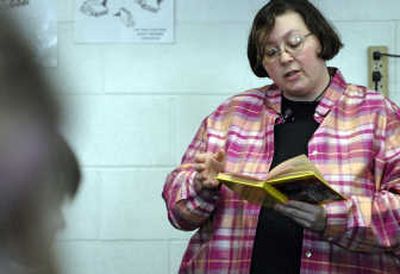Bond would modernize schools

Residents of the East Valley School District will be asked to approve a $33 million bond on the March 11 ballot, but it shouldn’t cost more than residents are already paying for an $11.9 million bond passed in 1996.
“Right now our current estimated bond is $1.50 per $1,000 in assessment,” said district superintendent Debra Howard. “We don’t expect our new bond to be more than that. That was an important piece of our planning, that the new bond will not be more than the retiring bond.”
The bond, if passed, would pay for complete modernization of Mountain View Middle School, East Valley Middle School and Otis Orchards Elementary. It would also cover technology, communications and security systems upgrades at all the elementary schools. The district will also be eligible for $22.7 million in matching funds from the state. The new bond would not take effect until the previous bond is paid off.
The district spent the last two years evaluating each school in the district and deciding what the most pressing needs were. “All of ours, except for Trent, fell into a category of needing improvement, kind of in the poor range,” Howard said. “We’ve got eight schools. To do seven of them all at the same time was kind of spendy.”
East Valley High School does need improvements, but doesn’t quality for state matching grants and would cost about $80 million. Administrators decided to leave it alone for now. “We want to extend the life of the schools another 30 years,” said Howard. “Then we can move on to the high school. We didn’t feel like we could take it on first because the needs of the middle schools were a higher priority.”
All the schools slated for improvements have heating system, plumbing and wiring problems. Most still have their original equipment and are not up to current code. East Valley Middle School was built in 1968 and Mountain View Middle School was built in 1978.
Mountain View was hit by lightning two years ago, which shorted out the school’s reader board, intercom system and phone systems. “We did replace the fried parts, but it has intermittent issues,” said the district’s technology director, Brian Wallace.
Phone calls at the school often cut off unexpectedly. There’s no voice mail and teachers don’t have their own phones. In many classrooms the heating system is so loud that the teachers have to wear microphones to be heard. The toilets and other fixtures in the bathrooms are 30 years old. Some of the ovens in the kitchen don’t work and there are a limited number of Internet connections. The building also lacks a sprinkler system, which wasn’t required when the school was built.
While the list of problems is long, Mountain View Principal Jim McAdam can’t fault the maintenance staff or custodians. Things are simply wearing out. “The guys do a great job,” he said. “You can only Band-Aid something so much.”
There are very few security cameras in the schools and more will be added if the bond passes. The district also wants to install a card access system at the schools to replace keys. Currently, if someone loses a key or leaves the district and doesn’t return a key, the entire building affected must be re-keyed, Howard said.
Kay Sieck, a parent and community member, was chairman of the strategic planning committee that made the repair recommendations. She and other committee members toured each school, visiting boiler rooms and examining plumbing. “People won’t see a huge exterior change to any of these buildings,” she said. “We’re looking at the internal workings of the building to make them better.”
During her tours she particularly noticed the aging heating systems. “One room you walk into, you want a coat on,” she said. “You can go down to the other end of the hall and want a pair of shorts.”
Sieck said that people in the community she has spoken to have been supportive of the bond, even those without children in the school system. She has been asked about the recent budget problems the district had, which resulted in fewer programs and less staff. “Our current administration has worked extremely hard to turn that around,” she said.
The district has no choice but to pass a bond, she said. When things go wrong, they’re expensive to fix and the district doesn’t have the money to pay for it. “The operating budget just isn’t there,” she said.
Some thought has been given to how to shuffle students around while the work is being done. One option is to bring in portable classrooms until construction is complete. “We’ll do as much as we can during summer months, but the scope of the project means that some of it will occur during the school year,” Howard said. “We don’t have enough classrooms in the district to shut down entire schools and move kids.
“Given that we haven’t passed the bond, we really haven’t though a whole bunch about it. We would figure out a good solution that would not be hugely disruptive to the educational process.”